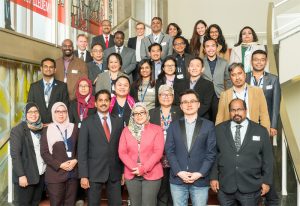Companies can dip-their-toes in IoT waters by pinpointing areas where they face the most cost/challenges, and brainstorming how digitalisation & sensors could help.
K-Pintar and the European School of Management & Technology (ESMT), in collaboration with HRDF, recently organised a tour of German innovation to highlight the importance of Malaysian businesses in preparing for Digitalisation, Industry 4.0 and implemention of the Internet of Things (IoT).
The 7-day programme included classes, industry talks, site visits and tours of manufacturing plants in Berlin, Stuttgart and Munich. The first batch of 25 participants (who were from various print publications, media outlets and digital agencies such as TheMalaysian.com) interacted with futuristic technology to grasp the full impact of the coming revolution, and gain insight into how companies were transforming their processes.
Industry 4.0 generally tends to conjure up visions of a highly automated manufacturing plant – where computers analyse and decide on the most efficient way to get a job done, and then robots execute the formulated plan.
However, between watching a Mercedes S-Class get built by robots at the Daimler production facility to waving their hands in the air to flip the pages of a digital book (in the style of “Minority Report”) at the futuristic Fraunhofer Heinrich Hertz Institute (HHI) laboratory, perceptions changed. It quickly became clear that the Fourth Revolution was akin to a tidal wave with far-reaching consequences.
Depending on its implementation, the combination of Digitalisation, Industry 4.0 and IoT, will require a complete remodeling of business strategies and processes in various sectors – including those in service based industries – whether they are B2B or B2C oriented.
According to Vodafone’s “IoT Barometer 2017/18” report, 77% of Asia’s businesses see IoT as mission-critical to their businesses, and 88% have increased their use of IoT in the past 12 months.
How IoT Can Help Service-Based Businesses
When it comes to the Internet of Things (IoT), it all starts with sensors. Sensors gather data in real-time – such as temperature levels, humidity, ambient lighting etc – and constantly sends its latest figures to an online software (also known as middleware). The software can automatically notify staff of emergencies, or recommend which items need to be attended to first.
The types of sensors available are so varied, that we are only limited by our imagination as to how to utilise them effectively. Companies in Malaysia can dip-their-toes in IoT waters by pinpointing areas where they have the highest cost, or face the most challenges, and then brainstorming how sensors could help.
Common Types of IoT Sensors
For example, a water supply & filtration company with limited manpower could be incurring unnecessary cost by performing maintenance on a scheduled, routine basis. Teams may be visiting offices even if the water dispenser is under-utilised and in perfect working condition.
To avoid this, water dispensers could be outfitted with temperature or usage sensors. When a boiler is no longer producing water at the right temperatures, or general usage has hit a certain level, the software will email the supplier. Maintenance personnel can then be dispatched – thereby reducing cost, whilst maintaining (or even increasing) client satisfaction. Sensors could also keep track of the water supplies in stock, when the amount of water is running low, an email from the dispenser could notify both the client and the supplier. The client’s Procurement Dept could simply click a button online and easily have the next order placed.
If we wanted to sprinkle some Industry 4.0 magic on there, a robot in the supplier’s stock room would automatically box up the order, address it and schedule it for delivery based on priority (because a high-priority client may need same day delivery, whilst another client may be able to wait a day or two – and yes, the helpful software would have a formula that works this out for itself).
With the variety of sensors available, the possibilities are endless.
- Elevator Maintenance: sensors can monitor daily usage and an app could schedule maintenance visits based on the statistics
- Hotels : sensors can detect malfunctioning air conditioning or shower temperature levels
- Substations : sensors can monitor transformers to detect overheating and dangerous ultrasonic levels
- Garbage collection : sensors on bins can help apps prioritise collection routes, based on which area has the most garbage for that day
- Hospitals and elderly care homes : wearable technology to monitor heart rate, blood pressure, electrocardiogram (ECG) and patient location can notify medical staff of emergencies or senior citizens who have wandered off
The sensors, the softwares, the robots. They are all just waiting for the different masterminds in forward-thinking companies, to link them together and take their company into the next era.
There is no doubt that a revolution is coming – and all companies must embrace it to stay relevant. Whether you are a traditional service based firm, or running a web design company in Malaysia, take a moment to envision how digitalisation could enhance the way you deliver services and remain competitive.
For details on the Industry 4.0 programme, please visit K-Pintar. To learn more about Kristy or invite her to speak at your next event, click here.


